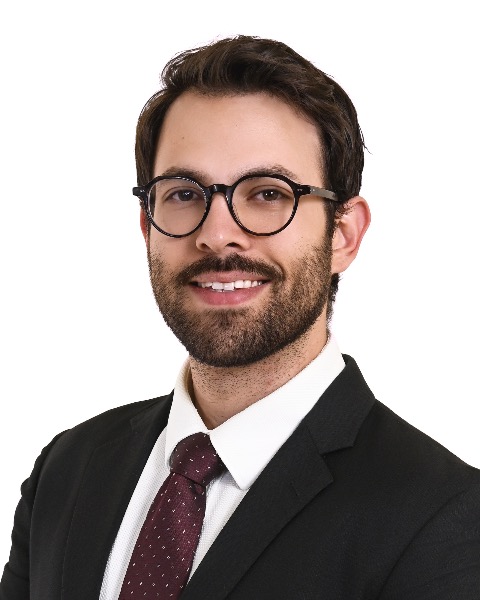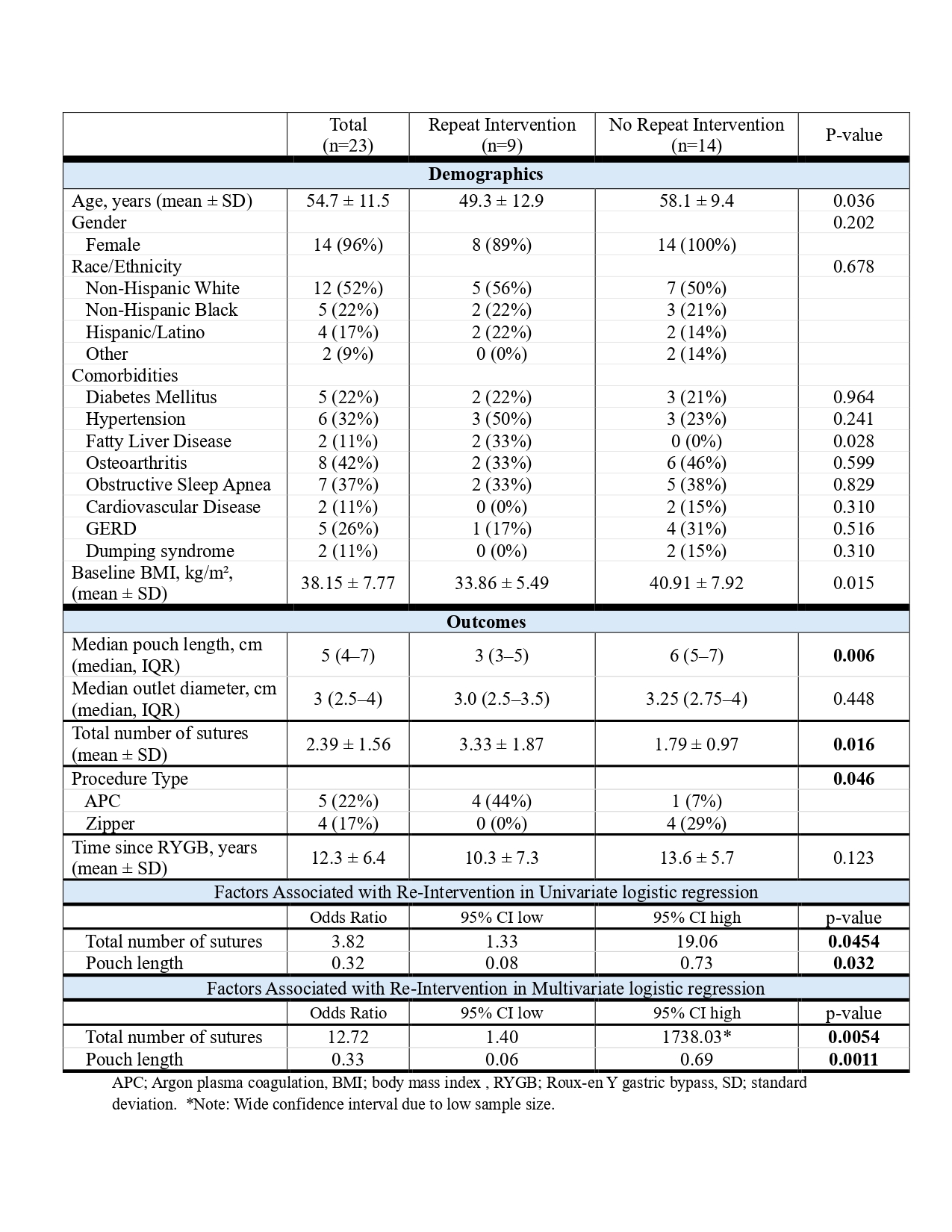Monday Poster Session
Category: Interventional Endoscopy
P3525 - Shorter Pouch Length Predicts Reintervention After TORe for Weight Regain Post-Gastric Bypass
Monday, October 27, 2025
10:30 AM - 4:00 PM PDT
Location: Exhibit Hall

Jose Garcia-Corella, MD (he/him/his)
UCLA-Kern Medical Center
Bakersfield, CA
Presenting Author(s)
Jose Garcia-Corella, MD1, Meghna Yalamanchi, MD2, Melanie Ramirez, 3, Cameron M. Quon, MD4, Vidhi Singh, 3, Elizza Villarruel, 3, Kelsy N. Larios, BS3, Eric Simms, MD3, Adarsh Thaker, MD3, Venkataraman R. Muthusamy, MD, MAS3, Danny Issa, MD5
1UCLA-Kern Medical Center, Bakersfield, CA; 2Olive View-UCLA Medical Center, Sylmar, CA; 3David Geffen School of Medicine at UCLA, Los Angeles, CA; 4University of Southern California, Los Angeles, CA; 5David Geffen School of Medicine at UCLA, West Hills, CA
Introduction: Transoral outlet reduction (TORe) is safe and effective in the management of weight recidivism after Roux-en-Y gastric bypass (RYGB). A subset of patients develops a recurrence of outlet dilatation, leading to an inadequate response to the initial procedure or weight regain. Although repeat TORe often yields successful outcomes, the factors causing the initial failure are not well understood.
Methods: This is a single-center, retrospective study from a large endobariatric clinic, enrolling adult patients who required repeated TORe for weight regain after the index intervention. A matched group of patients who did not undergo a repeated TORe was included for comparison. All patients were followed for at least 1 year post-intervention. Demographic, clinical, and procedural factors were assessed using Welch’s T-test, Fisher’s exact test, and multivariate logistic regression.
Results: Twenty-three patients were evaluated: nine underwent repeat TORe, and 14 did not. The mean age was 54 years, and 96% were female. The median pouch length was 5 cm (IQR: 4–7), and the mean number of sutures placed was 2 ± 1.56. Shorter pouch length was associated with increased odds of reintervention (OR = 0.32; 95% CI: 0.08–0.73; p = 0.032); Figure. Specifically, each 1-cm decrease in pouch length was associated with a 73% increase in the odds of repeat TORe (OR = 0.27; 95% CI: 0.06–1.22; p = 0.089). A higher number of sutures was also associated with greater odds of reintervention (OR = 3.82; 95% CI: 1.33–19.08; p = 0.0454). Notably, none of the four patients treated with the TORe-Zipper technique required reintervention, significantly lower than other techniques (p = 0.048), Table 1. No significant associations were observed between reintervention and gastric outlet diameter, time from RYGB to TORe, or diabetes status. On multivariate analysis, pouch length remained an independent predictor (OR = 0.33; p = 0.0011), and suture count continued to predict reintervention (OR = 12.7; p = 0.0054).
Discussion: In this retrospective cohort, shorter pouch length was significantly associated with an increased likelihood of repeat endoscopic intervention for weight recidivism following Roux-en-Y gastric bypass. Pouch length remained an independent predictor in multivariate analysis. Among TORe techniques, the APC-based approach was more frequently associated with reintervention, while the Zipper technique was not.

Figure: Table 1: Comparison of Demographics and Outcomes

Figure: Figure 1: A. Probability of Repeat TORe vs Pouch Length. B. Probability of Repeat TORe vs Number of Sutures. C. Predicted Probability of Repeat TORe by Pouch Length.
Disclosures:
Jose Garcia-Corella indicated no relevant financial relationships.
Meghna Yalamanchi indicated no relevant financial relationships.
Melanie Ramirez indicated no relevant financial relationships.
Cameron Quon indicated no relevant financial relationships.
Vidhi Singh indicated no relevant financial relationships.
Elizza Villarruel indicated no relevant financial relationships.
Kelsy Larios indicated no relevant financial relationships.
Eric Simms indicated no relevant financial relationships.
Adarsh Thaker: Boston Scientific – Consultant.
Venkataraman Muthusamy: Boston Scientific – Consultant.
Danny Issa: Boston Scientific – Consultant.
Jose Garcia-Corella, MD1, Meghna Yalamanchi, MD2, Melanie Ramirez, 3, Cameron M. Quon, MD4, Vidhi Singh, 3, Elizza Villarruel, 3, Kelsy N. Larios, BS3, Eric Simms, MD3, Adarsh Thaker, MD3, Venkataraman R. Muthusamy, MD, MAS3, Danny Issa, MD5. P3525 - Shorter Pouch Length Predicts Reintervention After TORe for Weight Regain Post-Gastric Bypass, ACG 2025 Annual Scientific Meeting Abstracts. Phoenix, AZ: American College of Gastroenterology.
1UCLA-Kern Medical Center, Bakersfield, CA; 2Olive View-UCLA Medical Center, Sylmar, CA; 3David Geffen School of Medicine at UCLA, Los Angeles, CA; 4University of Southern California, Los Angeles, CA; 5David Geffen School of Medicine at UCLA, West Hills, CA
Introduction: Transoral outlet reduction (TORe) is safe and effective in the management of weight recidivism after Roux-en-Y gastric bypass (RYGB). A subset of patients develops a recurrence of outlet dilatation, leading to an inadequate response to the initial procedure or weight regain. Although repeat TORe often yields successful outcomes, the factors causing the initial failure are not well understood.
Methods: This is a single-center, retrospective study from a large endobariatric clinic, enrolling adult patients who required repeated TORe for weight regain after the index intervention. A matched group of patients who did not undergo a repeated TORe was included for comparison. All patients were followed for at least 1 year post-intervention. Demographic, clinical, and procedural factors were assessed using Welch’s T-test, Fisher’s exact test, and multivariate logistic regression.
Results: Twenty-three patients were evaluated: nine underwent repeat TORe, and 14 did not. The mean age was 54 years, and 96% were female. The median pouch length was 5 cm (IQR: 4–7), and the mean number of sutures placed was 2 ± 1.56. Shorter pouch length was associated with increased odds of reintervention (OR = 0.32; 95% CI: 0.08–0.73; p = 0.032); Figure. Specifically, each 1-cm decrease in pouch length was associated with a 73% increase in the odds of repeat TORe (OR = 0.27; 95% CI: 0.06–1.22; p = 0.089). A higher number of sutures was also associated with greater odds of reintervention (OR = 3.82; 95% CI: 1.33–19.08; p = 0.0454). Notably, none of the four patients treated with the TORe-Zipper technique required reintervention, significantly lower than other techniques (p = 0.048), Table 1. No significant associations were observed between reintervention and gastric outlet diameter, time from RYGB to TORe, or diabetes status. On multivariate analysis, pouch length remained an independent predictor (OR = 0.33; p = 0.0011), and suture count continued to predict reintervention (OR = 12.7; p = 0.0054).
Discussion: In this retrospective cohort, shorter pouch length was significantly associated with an increased likelihood of repeat endoscopic intervention for weight recidivism following Roux-en-Y gastric bypass. Pouch length remained an independent predictor in multivariate analysis. Among TORe techniques, the APC-based approach was more frequently associated with reintervention, while the Zipper technique was not.

Figure: Table 1: Comparison of Demographics and Outcomes

Figure: Figure 1: A. Probability of Repeat TORe vs Pouch Length. B. Probability of Repeat TORe vs Number of Sutures. C. Predicted Probability of Repeat TORe by Pouch Length.
Disclosures:
Jose Garcia-Corella indicated no relevant financial relationships.
Meghna Yalamanchi indicated no relevant financial relationships.
Melanie Ramirez indicated no relevant financial relationships.
Cameron Quon indicated no relevant financial relationships.
Vidhi Singh indicated no relevant financial relationships.
Elizza Villarruel indicated no relevant financial relationships.
Kelsy Larios indicated no relevant financial relationships.
Eric Simms indicated no relevant financial relationships.
Adarsh Thaker: Boston Scientific – Consultant.
Venkataraman Muthusamy: Boston Scientific – Consultant.
Danny Issa: Boston Scientific – Consultant.
Jose Garcia-Corella, MD1, Meghna Yalamanchi, MD2, Melanie Ramirez, 3, Cameron M. Quon, MD4, Vidhi Singh, 3, Elizza Villarruel, 3, Kelsy N. Larios, BS3, Eric Simms, MD3, Adarsh Thaker, MD3, Venkataraman R. Muthusamy, MD, MAS3, Danny Issa, MD5. P3525 - Shorter Pouch Length Predicts Reintervention After TORe for Weight Regain Post-Gastric Bypass, ACG 2025 Annual Scientific Meeting Abstracts. Phoenix, AZ: American College of Gastroenterology.
